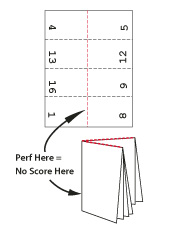A reader recently called in with this problem: the center spread of his saddle stitched book was falling out periodically. The center signature was a 16pp 8.5 x 11 and the question was "how can we modify the score on the spine to prevent the center pages from falling out?"
Here's our 2-part answer:
First: don't score the spine...it's almost never needed  when running 16pp sigs (as shown in the diagram) as long as you perf the head of the signature. In our experience with signature work, it is extremely unusual for a spine score to be the most effective method. (Yes, there may be rare exceptions to this, perhaps when running a 100# text with the spine against the grain.)
when running 16pp sigs (as shown in the diagram) as long as you perf the head of the signature. In our experience with signature work, it is extremely unusual for a spine score to be the most effective method. (Yes, there may be rare exceptions to this, perhaps when running a 100# text with the spine against the grain.)
The correct perforation, typically a 12 or 17 toothblade (TPI) on a 35mm shaft, will let out the air from the signature as it folds without letting it fall apart. Some experimentation with perf blades is important to discover what works best with the stocks you run. For the best perforation technology in the business check out our different tooling options here: single perforations with our Technifold Micro Perf Kits and multiple, close proximity perforations with the Technifold Multi-Tool or CP Applicator.
By perfing the head, the last fold in the 16pp section becomes as simple as folding a 4 pager. If you are skeptical and have "always scored the spine," give this perf method a try.
- It eliminates one more variable in the folding operation.
- It makes folding easier and more accurate with a lot less work.
- It speeds makeready.
- It makes troubleshooting FAR simpler. Revisiting one of our favorite rules of all time...the 80-20 rule...you'll find that using this technique, 80% of your troubleshooting problems with signature folding will now be confined to the main parallel section.
Second: The saddle stitcher could be the culprit. Very light stock is more susceptible to tearing. Compression could be a touch too tight, clinchers might be set slightly off, or the mechanism for transferring the book from the gathering chain to the trimmer infeed could be adding undue stress to the center spread.
The Bottom Line: Eliminate that score with a perforation on the head and then if needed, double check the stitcher.

